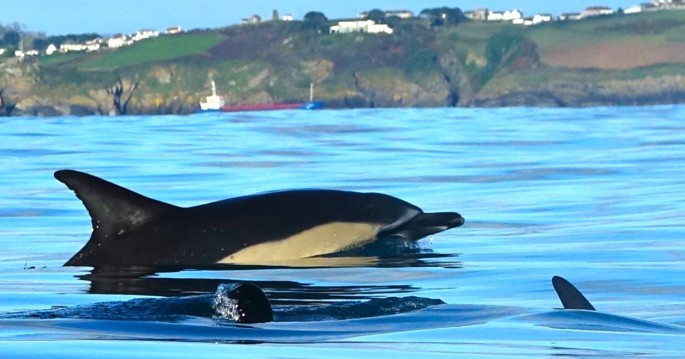
November has provided lean pickings for the Lone Kayaker.
My camera has made very few excursions from the cosiness of its dry-bag.
The weather hasn’t helped. Most of my paddling trips have been along the rivers and up the estuaries to provide a bit of protection from the wind. I’ve seen a few Kingfishers, a handful of seals and several otters which is always a thrill.
Most have been fleeting glimpses although during the one prolonged view of a otter fishing in the River Torridge my camera decided to go on strike.
Out along the coast I have encountered the occasional porpoise and witnessed a tremendous dogfight between a pair of peregrines and a woodpigeon. Clouds of feathers flew everywhere but amazingly the woodpigeon made a successful escape into a chink in the cliffs.
All of which I failed to capture on film.
The big kick up the pants came a couple of days ago.
A day which promised blue skies and oily calm seas. BIG excitement.
I didn’t decide my launch location until I was in the car heading for the south Cornwall coast. It had to be Fowey…such an easy kayak put-in and only a mile paddle to the open sea. There are no real tidal currents to worry about so I could spend as much time as I liked far from the shore in about as relaxed a manner as possible.
As I emerged from the mouth of the estuary I checked in with the National Coastwatch Observers at Polruan and paddled directly offshore.
It was all worryingly quiet. No Gannets, very few gulls and no sound of any splashes or puffs. I kept stopping but all I could hear was deafening silence.
Until I reached about four miles offshore, that is.
That’s where things suddenly started to hot up. I paddled over to investigate a little flurry of Kittiwakes that were circling around a fizzing patch of water.

It was a compact baitball of small fish which looks like Pilchards (aka Cornich Sardines).
Also in attendance were a large numbers of auks that were scattered about, croaking in a strangely primeval manner.
They were mainly Razorbills…

With a handful of Guillemots thrown in for good measure, and comparison…

I was intrigued by a very small, pale floaty bird which I thought may have been a Phalarope, but it turned out to be a Little Gull. I’ve only seen two or three of these before from the kayak seat…

A short distance further out the BIG action started to kick off.
The silence was torn up by an explosion of water behind me which I knew must have been a tuna. I swung round just in time to see an enormous fish, far bigger than a dolphin, jump clear of the water.
In keeping with my photographic failures of the last month, I spectacularly missed the opportunity for the big pic and just managed to snap the spiky fin as the fish disappeared. It didn’t reappear, needless to say.

I was relieved when I heard a small posse of Common Dolphins approaching, with their characteristic polite and delicate splashing…in great contrast to the explosive chaos of the Tuna.
Even better, they were swimming towards me so all I had to do was wait.

As usual the little group came over to investigate the weirdo in the mould-covered kayak and then seemed to lose interest and moved on.

But then they seemed to have a change of heart and came back to the side of my kayak, as though they had decide that I might be an item of interest after all.
In the manner of puppies waiting for the ball to be thrown, they seemed to be egging me on. So I stoked up the boilers and cranked up the speed.
The dolphins responded as I had hoped and somehow got some enjoyment out of my pathetic pressure wave. They seemed to be gliding along beside me without twitching a muscle.
I spent a prolonged period staring eye to eye with one adult dolphin as it cruised effortlessly just below the silky smooth surface. As it tilted on its side to get a better look I tried to convey a similarly relaxed expression even though I was twanging every fibre of my being in paddling fast enough to keep their attention.
Dolphins are far to clever to be fooled, however. They took pity on me, probably when they saw the veins on my temples starting to bulge, and dashed off to look for a fishy snack.
A memorable minute of dolphin magic…
Yesterday the mini-dolphin bonanza continued, this time off the South Devon coast in Torbay. The see was bursting with little silver fish. Kittiwakes were circling everywhere with Guillemots, Razorbills, Gannets and a few Divers joining in the feast.
Where there are feeding seabirds, there are usually porpoises and/or dolphins. On this occasion it was both!


















































































































